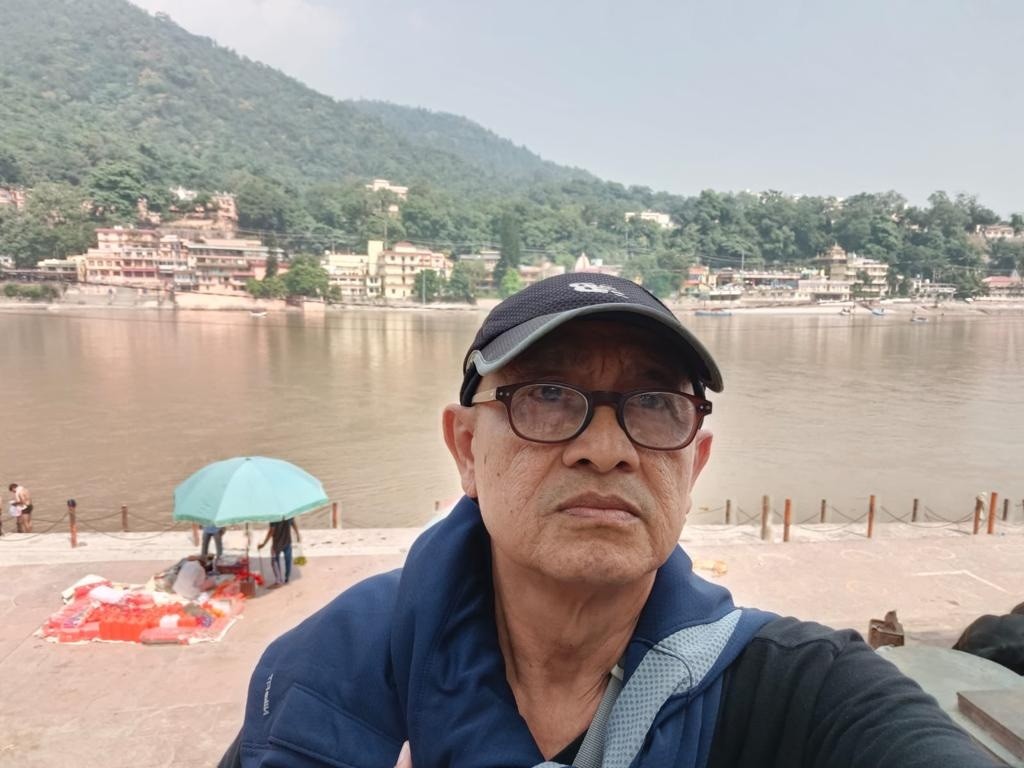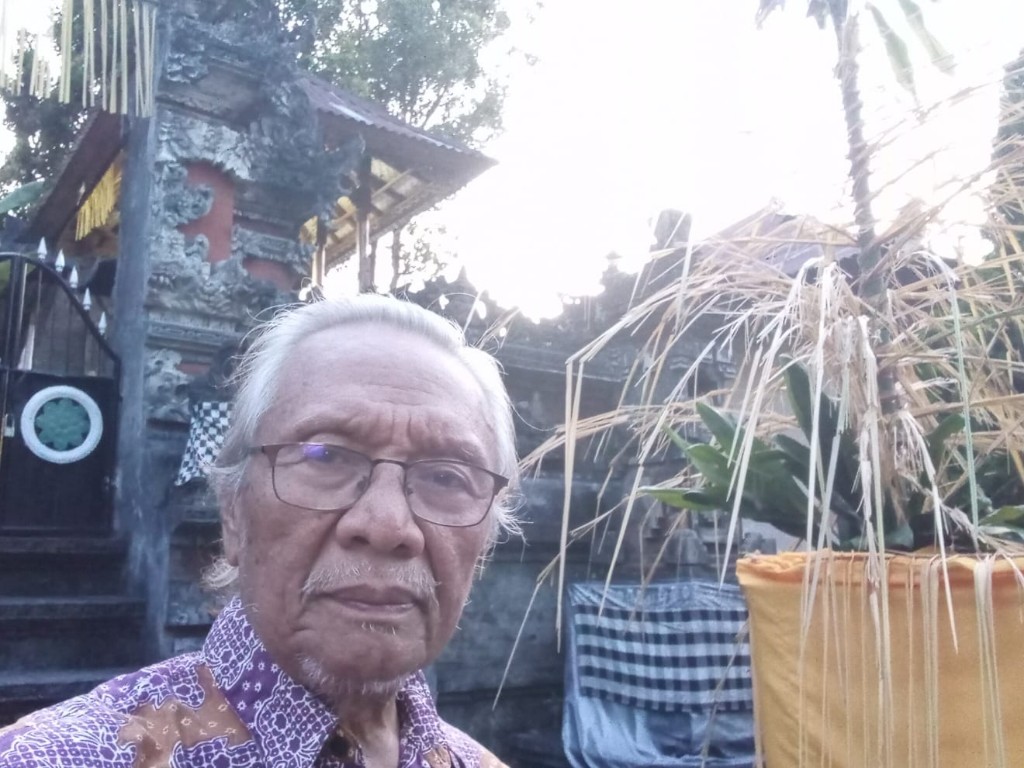
The Spirituality of the Ganges River
Admin - atnews

Denpasar (Atnews) - Humanist Putu Suasta had time to walk along the Ganges River in the Haridwar area, Rishikesh, India (Bharat), which is highly revered and sacred to Hindus (Sanatana Dharma).
The Ganges River flows 2,525 kilometers from the upstream of the Himalayas and is visited by millions of people from all over the world. The most widely accepted length of the Ganges is 1,569 miles (2,525 km), and its watershed is estimated to be about 416,990 square miles (1,080,000 square km).
The river is revered by Hindus who offer food and flowers to the river as a sacrament. During major religious festivals, millions of Hindus from all corners of India and the world travel to the river to immerse themselves in the water to cleanse their souls. This river is also believed to provide spiritual protection for the deceased.
Many cremation temples are located on the banks of the Ganges River, and Hindus throw the ashes of the dead into the river to ensure the soul has a safe passage to heaven. The waters of the Ganges River are believed to be the route to the World of the Ancestors (Pitriloka).
Ganges water is extraordinarily powerful, even with a drop of Ganges water when mixed with ordinary water, the ordinary water becomes Ganges water with all its power and purity.
Moreover, research results from researchers found and proved that pure water of the Ganges, even if stored for a long period of time, will still maintain its purity.
While visiting this holy area, especially when the moment of Aarati Gangga Puja, people will feel touching and lasting forever.
This was conveyed by Suasta, who had just arrived from India, after traveling in October 2023, and also made a several-day visit to Vietnam as part of an invitation to an international meeting on the environment, equality of women, human rights and global pluralism.
During a week in India, Suasta specifically visited Akshardham, which is a Hindu temple complex covering approximately 200 hectares on the outskirts of metropolitan Delhi, India. It also includes Kurukshetra, Haridwar, Rishikesh and Mathura.
Previously, Suasta had visited India five times, as well as Angkor Wat in Siem Reap, Cambodia, a Hindu temple complex covering an area of 100 square km built 1000 years ago, and also visited the Batu Caves Temple of Hindu in Malaysia some time ago.
Putu Suasta feels grateful to have had the opportunity to perform meditation puja (dharsan) to Lord Murugan and exchange ideas with the local community leaders some time ago in Selangor, Malaysia.
Lord Murugan is a Hindu God who is famous among the Tamil people in the state of Tamil Nadu in India, and Sri Lanka. This god is also known by various names, such as Kartikeya, Kumara, Shanmukha, Skanda, and Subramaniam.
Depicted as a god with a young appearance, armed with a spear and riding a peacock, Lord Murugan turns out to be the god of war and protector of the Tamil land and nation.
His arrival was in a series of meetings for NGO Leaders throughout Asia or meetings of International Non-Governmental Organization (NGO) Leaders for nine days in Kuala Lumpur and Songkhla, Southern Thailand. The NGO leadership meeting activities were held in Singapore, Malaysia and Thailand.
Putu Suasta is an alumnus of Gadjah Mada University, Yogyakarta and Cornel University, New York, a speaker at the University of Kebangsaan Malaysia, Songklha University in Southern Thailand, Thaksin University and the National University of Singapore.
NGO participants who attended the meeting came from across countries, namely Cambodia, Laos, Malaysia, Singapore, India, Vietnam, Sri Lanka, China, Taiwan, the Philippines and Indonesia.
Suasta admitted that he had learned a lot from India that the holy places of Hindu (Sanatana Dharma) and had even traveled to the country five times within more than 30 years.
Moreover, he had lived in holy places for Hindus, namely Punjab, Varanasi, also called Benares, Banaras, or Benaras, or Kashi or Kasi, which is a holy city of Hinduism on the banks of the Ganges River, located in the state of Uttar Pradesh in northern India.
Varanasi, for Hindus, is like Mecca for Muslims or the Vatican for Catholics. Meanwhile, in India, Putu Suasta had time to interact with saints or sadhus.
Suasta further explained that the Ganges River flows along 2,525 kilometers from the Himalayas to the Bay of Bengal in northern India and Bangladesh.
The headwaters of the Ganges River start from the Himalayas at an altitude of 3,892 meters above sea level originating from the Gangotri Glacier in the state of Uttarakhand, India.
The glacier is at an elevation of 12,769 feet (3,892 meters). The Ganges begins further downstream where the Bhagirathi and Alaknanda Rivers meet. When the Ganges River flows out of the Himalayas, it forms a narrow and steep canyon.
The Ganges River begins at the confluence of the Bhagirathi and Alaknanda Rivers, and is part of a larger river valley connecting with the Brahmaputra and Meghna rivers. The tributaries of the Ganges (freshwater streams flowing into the Ganges) include the water sources of the Bangladesh, Nepal, and Tibet.
The annual rainy season, running from March to May, also supplies fresh water to the river. Once the river reaches the Bay of Bengal, it forms the Ganges Delta, the largest river delta in the world and a very fertile region for plant growth.
River delta sediments contain remnants of forest vegetation, clay, lignite, and layers of peat that enrich the surrounding soil.
The Himalayas are also home to Mount Everest, the highest mountain in the world. Goddess Ganga (Ganga Devi) is often depicted riding a Makra (a hybrid creature with a crocodile head and a dolphin tail).
As the Ganges flows further downstream, it changes direction several times and is joined by many other tributary rivers. The main rivers flowing into the Ganges are: Ramganga, Gomti, Ghaghara, Gandaki, Burhi Gandak, Koshi, Mahananda, Tamsa, Yamuna, Son, and Punpun.
There are also several cities and towns that the Ganges River passes through on its way downstream. Some of them are Chunar, Kolkata, Mirzapur, and Varanasi. Many Hindus visit the Ganges River in Varanasi because it is considered the holiest city. Therefore, the culture of the city is also closely related to the river because it is the holiest river in Hinduism.
For most of its course, the Ganges flows through India, although its large delta in the Bengal region, which it shares with the Brahmaputra River, mostly located in Bangladesh. After the Ganges River flows out of India and into Bangladesh, its main branch is known as the Padma River. Theis Padma River joins downstream with major rivers such as the Jamuna and Meghna rivers.
After joining the Meghna, it takes on the name before flowing into the Bay of Bengal. But prior to entering the Bay of Bengal, this river creates the largest delta of the world, the Ganges Delta. This region is a very fertile, sediment-laden region that covers an area of 23,000 square miles (59,000 square km).
The Ganges River is the third largest river in the world by discharge and the 34th longest river in the world.
The average depth of the river is 16 meters, and the maximum depth is 30 meters. Meanwhile, the mouth of the Ganges River forms the largest delta of the world, known as the Sunderbans, and was declared a World Heritage Site by UNESCO in 1997. Its area reaches more than 105,000 square kilometers.
This river has the second largest water discharge in the world, and its watershed is the most densely populated in the world with more than 400 million people living in it. Morever, there are many holy places along the Ganges River including Gangotri, Haridwar, Allahabad, Varanasi and Kali Ghat.
“I had ever lived there, in some of these holy places,” said Suasta in his conversation in Denpasar, last Wednesday
What is more interesting is that Hindus from all over the world will gather to take part in the Kumbh Mela event, a Hindu religious ritual in the form of mass bathing on the banks of the Ganges River celebrated in four places namely Haridwar, Prayag, Ujjain and Nashik.
Besides, the glory of Ganga Devi has been known throughout the ages. The Ganga is first mentioned several times in the Rig Veda, considered the earliest of the four Vedas (principle sacred texts that form the basis of Vedic and Hindu thought).
In Rig Veda 3.58.6 is stated, “Your ancient home, your auspicious friendship, O Hero, your riches are on the banks of the Jahnavi River [another name for Ganga].”
Moreover, the coming down of Ganga Devi to earth is related to the story of the dwarf Vamana Avatara, the fifth incarnation of Lord Vishnu. In which, there was an evil king named Bali who was very arrogant. In a plan to end his crimes, Vamana went to Bali and asked him for three steps of land.
Bali haughtily agreed, thinking it was only three small steps from a dwarf. However, Vamana then took His cosmic form and placed one foot on the earth, one foot in the sky, and one foot on the head of Bali.
According to the story, it was at that time that Lord Vishnu stepped into heaven, and the Goddess Ganga was born. When stepping into heaven, Lord Brahma washed the feet of Lord Vishnu with great reverence. Water fell from his feet into kamandalu or pot of Lord Brahma, and from this water Ganga was then born.
Likewise, Ganga Devi descended into the world due to very heavy penance carried out by King Bhagiratha, that is why Ganga is then also known as Bhagirathi.
It is told of a king named Sagara who had sixty thousand (60,000) sons. One day, King Sagara decided to perform the Ashvameda ceremony, a ritual in which a horse is sent across the land to conquer and acquire a new kingdom and establish sovereignty. However, Lord Indra was jealous of King Sagara and decided to steal and hide his horse in the underworld.
King Sagara sent all of his sons to find the horse and after searching the whole earth, they found it in the underworld next to meditating sage, Kapila. As believing that Kapila was the thief, they began hurling insults at the great sage, thereby disrupting his practice.
Kapila opened his eyes–the eyes that had not been open for years –and with his spiritual power burned the entire 60,000 sons to ashes.
After death, there are many long and complicated rituals that Hindus must perform, including immersion of the ashes. However, because these sixty thousand sons were far away in the underworld, no one could perform their funeral rites, so they wandered as ghosts for many years.
For generations, the descendants of King Sagara tried, but unsuccessfully persuaded Ganga to come to Earth to purify the 60,000 sons of King Sagara.
Many years later, a descendant of King Sagara named Bhagiratha vowed intense penance to bring down Ganga from heaven to purify the ashes of his ancestors, thus washing away their sins and freeing their souls.
After much penance, Lord Brahma agreed to the wish of Bhagiratha and ordered the Ganga to flow down to the earth.
However, Ganga who is full of Shakti began to descend and she swept away everything that came in her way.
Bhagiratha prayed to Lord Shiva to stop Ganga from doing such action because he was the only one who is strong enough to stop her flow.
So, when Ganga fell from heaven, she got caught in the hair of Lord Shiva. The Ganga was purified through the touch of Lord Shiva and is released in calm streams from her hair to flow both on earth and in the underworld to purify and liberate not only the ancestors of Bhagiratha but also all the inhabitants of the earth.
The Ganga Devi who came down from heaven then flowed through the hair ties of the Lord Shiva, becoming increasingly holy because it has been in direct contact with the Lord Shiva. Even now, the Ganges is the holiest river in Hinduism according to what is written in the Vedas and various other holy puranas.
Ganga symbolizes coolness, purity of heart, forgiveness, compassion and purity. Ganga enriches the spiritual life of millions of Hindus who believe and worship Ganga as one of the manifestations of the gods.
It is believed that Ganga descended to the world to erase all human sins so that humans can achieve eternal liberation or moksha.
Ganges is the holiest river in Hinduism. This river is very famous in India and the world, and she is worshiped as a goddess, namely Goddess Ganga.
The water flow of the Ganges River is believed to come down from heaven to wash away all sins and purify humanity. According to various Hindu puranas, just the sight, name and touch of the Ganges River can purify and erase all sins, and can grant humans the ultimate goal, namely moksha.
On that account, Hindus in India will store water from the Ganges River in their homes, with the aim that if there are relatives who are about to dying, they will be given this water, of course the aim that when the person dies, they will receive forgiveness of sins and purification from the Goddess Ganga.
Likewise in Bali, in various religious ceremonies, Hindu people will begin with a purification ritual, either to purify oneself or all ceremonial materials and paraphernalia by sprinkling water having been prayed for or holy water.
During the cremation ceremony, before the body is cremated, various holy waters will be given which are obtained from various temples in the area where the person lives, as well as holy water having been invoked to Brahmin priests. This holy water is none other than the embodiment of the Ganges water which grants the elimination of sins, purification and moksha.
Actually, there are many mantras or slokas intended as puja and praise to Ganga. And almost every mantra and sloka expresses the awesomeness and holiness of the water from the Ganges. Ganga is the destroyer of all sins, suffering, and the bestower of all goodness.
Apart from that, Ganga also plays an important role in the Ramayana epic, where Lord Rama and his wife Sita perform tapasya along the river bank.
In the Mahabharata, Ganga gave birth to Devavrata, later known as Bhishma, the preceptor of the Kuravas and Pandavas. Later in the epic, Bhishma tells Yudhisthira about the greatness of Ganga and its ability to purify one from all sins. In Bhagavad Gita 10.31, Lord Krishna states while imparting supreme spiritual knowledge to Arjuna: “Among the purifiers I am the wind, among the wielders of weapons I am Rama, among the fishes I am the shark, and in the flowing rivers I am the Ganges.”
Goddess Ganga is the foster mother of Lord Kartikeya (Murugan), who is actually the son of Lord Shiva and Parvati. She is also the mother of Devavrata (also known as Bhishma), who is one of the most revered figures in the Mahabharata.
It is believed that the waters of the Ganges River will dry up at the end of Kaliyuga (dark age, current era) along with the Saraswati River, and the present era will soon end. Then, the next age (cycle) is Satyayuga or the age of truth. (GAB/001)

Baca Artikel Menarik Lainnya : Sm@rtDesa Solusi Digitalisasi Pedesaan









